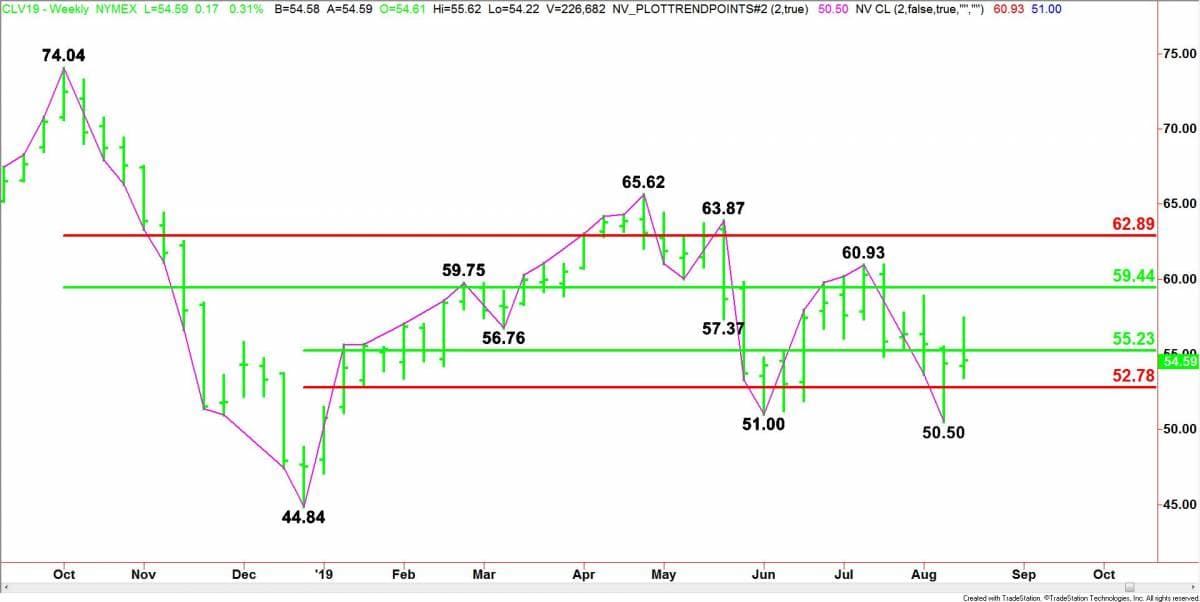U.S. West Texas Intermediate and international-benchmark Brent crude oil futures are trading nearly flat for the week as fears of recession are leading to increasing worries over future demand. An unexpected build in American Petroleum Institute (API) and U.S. Energy Information Administration (EIA) weekly inventories is also pressuring prices. We’re also feeling the impact of disappointing economic reports in China and Europe on Wednesday.
Limiting the downside risk is better-than-expected U.S. retail sales data and expectations of OPEC production cuts.
Recession Fears
Recession fears were raised earlier in the week after the bond market flashed a troubling signal about the U.S. economy. This increased worries over lower future demand. The fears were triggered when the yield on the benchmark 10-year Treasury note briefly broke below the two year rate, “an odd bond market phenomenon that has been a reliable indicator of economic recessions,” according to CNBC.
A recession occurred, on average, 22 months after the inversion, Credit Suisse research showed. Nonetheless, investors are bailing out of higher risk assets like crude and seeking shelter in Treasurys and Japanese Yen.
EIA Reports Surprise Inventories Build
On Wednesday, the government reported that U.S. crude stocks grew by 1.6 million barrels the week-ending August 9, compared with analyst expectations for a decrease of 2.8 million barrels, as refineries cut output, the EIA said…
U.S. West Texas Intermediate and international-benchmark Brent crude oil futures are trading nearly flat for the week as fears of recession are leading to increasing worries over future demand. An unexpected build in American Petroleum Institute (API) and U.S. Energy Information Administration (EIA) weekly inventories is also pressuring prices. We’re also feeling the impact of disappointing economic reports in China and Europe on Wednesday.
Limiting the downside risk is better-than-expected U.S. retail sales data and expectations of OPEC production cuts.
Recession Fears
Recession fears were raised earlier in the week after the bond market flashed a troubling signal about the U.S. economy. This increased worries over lower future demand. The fears were triggered when the yield on the benchmark 10-year Treasury note briefly broke below the two year rate, “an odd bond market phenomenon that has been a reliable indicator of economic recessions,” according to CNBC.
A recession occurred, on average, 22 months after the inversion, Credit Suisse research showed. Nonetheless, investors are bailing out of higher risk assets like crude and seeking shelter in Treasurys and Japanese Yen.
EIA Reports Surprise Inventories Build
On Wednesday, the government reported that U.S. crude stocks grew by 1.6 million barrels the week-ending August 9, compared with analyst expectations for a decrease of 2.8 million barrels, as refineries cut output, the EIA said in a report.
Additionally, at 440.5 million barrels, inventories were about 3% above the five-year average for this time of year, the EIA said.
Impact of Trade Dispute Spreading
China reported disappointing data for July, including a surprise drop in industrial output growth to a more than 17-year low and a slump in exports sent Germany’s economy into reverse in the second quarter. Both reports underlined the widening economic cracks as the trade war between the United States and China intensifies.
Trade Dispute Could Escalate
Early Thursday, China said it had to take necessary counter-measures to the latest U.S. tariffs on $300 billion of Chinese goods, according to its finance minister. The ministry also said the U.S. tariffs violate a consensus reached by leaders of the two countries and get off the right track of resolving disputes via negotiation, according to CNBC.
This announcement came just two days after President Trump announced the delay of tariffs until mid-December on some goods. That news drove crude oil prices sharply higher so counter-measures by China could weigh even further on crude prices throughout the day.
Markets Find Support
Early in the week, the markets were underpinned by optimism over potential production cuts by OPEC. A Saudi official on August 8 indicated more steps may be coming, saying “Saudi Arabia is committed to do whatever it takes to keep the market balanced next year.”
Late in the week, it’s better than expected U.S. retail sales data supporting prices. On Thursday, the U.S. reported that retail sales rose 0.7% in July as consumers bought a range of goods even as they cut back on motor vehicle purchases.
Technical Analysis
Weekly October West Texas Intermediate Crude Oil Technical Analysis

The main trend is down according to the weekly swing chart. A trade through $50.50 will signal a resumption of the downtrend. The main trend will change to up on a move through $60.93.
This week’s nearly flat close and two-sided trading suggests traders learned very little from the fundamentals.
The main range is $74.04 to $44.84. Its retracement zone at $59.44 to $62.89 is resistance. This zone stopped the buying the week-ending July 12 at $60.93.
The minor range is $44.84 to $65.62. Its retracement zone at $55.23 to $52.78 has been acting like support the last three weeks.
Weekly Technical Forecast
Based on this week’s price action and the current price at $54.28, the direction of the October WTI crude oil market next week is likely to be determined by trader reaction to the minor 50% level at $55.23.
Bearish Scenario
A sustained move under $55.23 will indicate the presence of sellers. If this creates enough downside momentum then look for the selling to possibly extend into the minor 61.8% level at $52.78. If this fails then look for a retest of the minor bottom at $50.50. This price is a potential trigger point for an acceleration to the downside. The weekly chart is wide open under $50.50 with the next potential target price $44.84.
Bullish Scenario
A sustained move over $55.23 will signal the presence of buyers. If this move generates enough upside momentum then look for a potential surge into the main 50% level at $59.44. Overcoming this level could lead to a test of the main top at $60.93. Taking out this level will change the main trend to up.
Conclusion
The trend is down on the charts, but the story driving the price action is helping to generate a slight sideways trade. Data from China and Europe suggest the global economy is facing recession, but domestic data indicates a growth trend in the United States. This may cause traders to ease up on concerns over demand, leading to a two-sided trade for a second week.
















